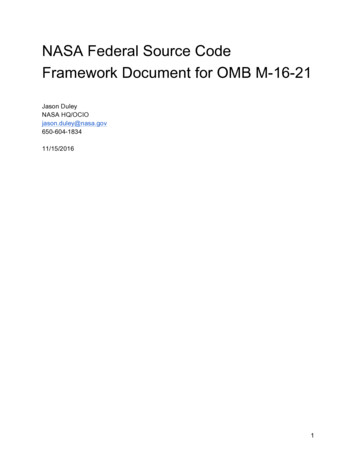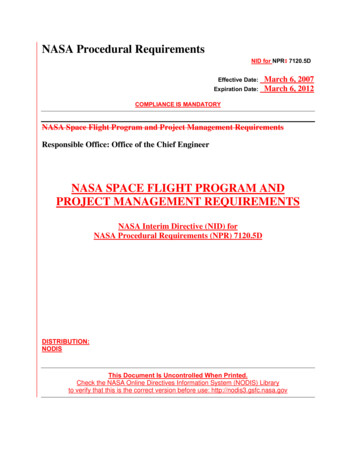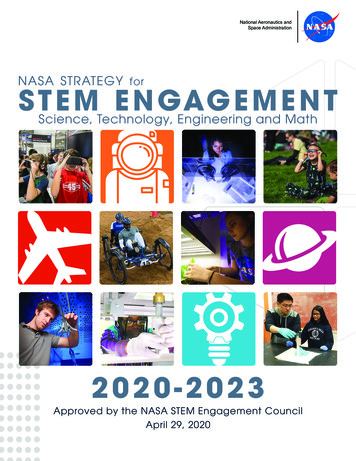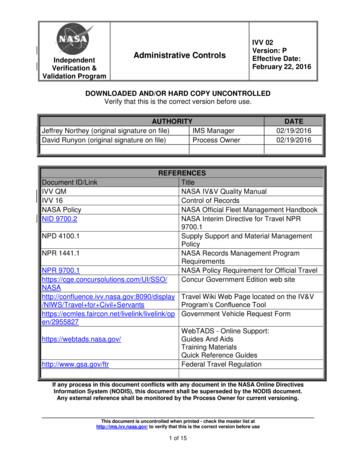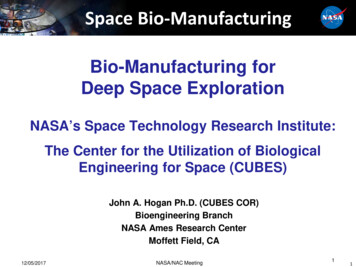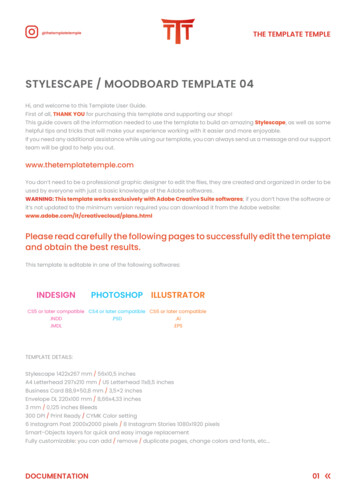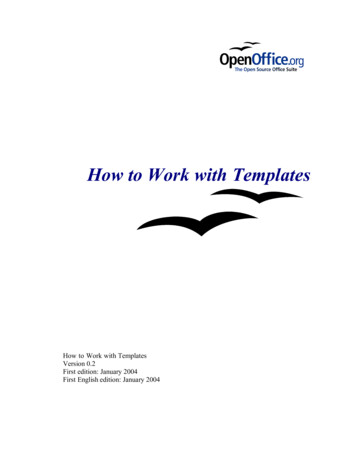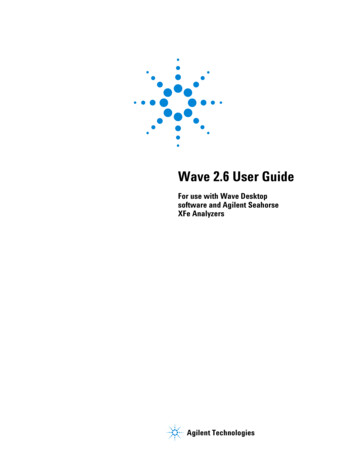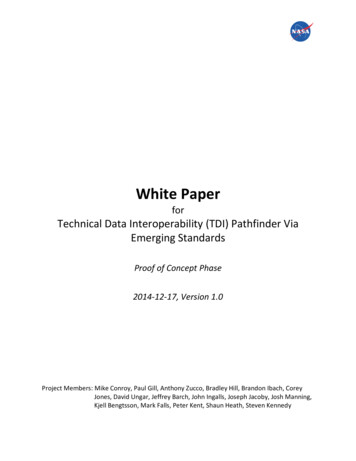
Transcription
White PaperforTechnical Data Interoperability (TDI) Pathfinder ViaEmerging StandardsProof of Concept Phase2014-12-17, Version 1.0Project Members: Mike Conroy, Paul Gill, Anthony Zucco, Bradley Hill, Brandon Ibach, CoreyJones, David Ungar, Jeffrey Barch, John Ingalls, Joseph Jacoby, Josh Manning,Kjell Bengtsson, Mark Falls, Peter Kent, Shaun Heath, Steven Kennedy
Table of ContentsA. Executive Summary. 3A-1 Overview . 3A-2 Problem Statement . 3A-3 Background . 4A-4 Conclusion . 5B. Project Activity . 6C. Use Cases . 17D. Risk Identification . 24E. Setbacks . 27F. Successes. 29G. Recommendation. 31G-1 Feasibility . 32G-2 Value . 32H. Appendix . 36H-1 Lessons Learned . 36H-2 Benchmarking . 37H-3 Description of TDI Industry Standards . 37H-4 Policies/Positions on TDI Standards . 61H-5 References . 652
A. Executive SummaryThis document describes the Technical Data Interoperability (TDI) Pathfinder Via EmergingStandards project, which was performed for NASA IT Labs and also supported by the NASAOffice of Chief Information Officer (OCIO). This project evaluated and tested a suite ofindustry standards for a proof of concept.A-1 OverviewThe TDI project (“TDI”) investigates trending technical data standards for applicability toNASA vehicles, space stations, payloads, facilities, and equipment. TDI tested COTSsoftware compatible with a certain suite of related industry standards for capabilities ofindividual benefits and interoperability. These standards not only esnable InformationTechnology (IT) efficiencies, but also address efficient structures and standard contentfor business processes. We used source data from generic industry samples as well asNASA and European Space Agency (ESA) data from space systems.The TDI project setup a system to simulate data exchanges by importing and exportingtechnical data between different life cycle phases, using standards-based software for: Product Data Management (PDM) and Computer Aided Design (CAD) – ISO10303 AP203 and AP214.Product Life Cycle Support (PLCS) – ISO 10303 AP239.Logistic Support Analysis (LSA) – S3000L and GEIA-STD-0007.Technical Publications (a.k.a. “Tech Pubs”, which includes work procedures,technical manuals, and training documents) – S1000D.A-2 Problem StatementMost NASA technical data systems still function with silo tools and methods which areinefficient in themselves or not compatible between systems or products. Data is oftenre-created or requires excessive searching. Long-term archiving and retrieval strategiesare either non-existent or limited. Most current and past space industry systems are notdesigned for efficiency or interoperability across the whole life cycle, between designand Operations & Support (O&S); nor between vehicles, space stations, payloads,facilities, and equipment; nor between NASA centers; nor between customers andsuppliers.NASA lessons learned have indicated that disparate technical data increases safety risksfrom poorly integrated elements, as outlined in the Columbia Accident InvestigationBoard (CAIB) report.Until recently, truly standardized interoperability was not possible. NASA wants moreindustry standards and interoperability, but sharing and breaking old ways is provingdifficult—even with new programs. NASA policy promotes interoperability and requiresto use industry standards where no comparable NASA standard exists. Without these, it3
will be difficult to meet some of NASA IT’s strategic goals, such as enhanced missionsuccess via efficient and effective access to enterprise information and collaborativefunctionality, innovative methods to attract a productive IT workforce, and partnershipof best practices with other government agencies and commercial partners.NASA agency strategic goals addressed by this project include: OCT Technology Area Roadmaps: Data interoperability in TA13 (Ground &Launch Systems Processing) and TA11 (Modeling, Simulation, IT, & Processing).KSC Technology Capability Areas: Life Cycle Optimization of Products, Projects,and Programs.Space Technology Grand Challenges: Economical Space Access, alleviating “40%of the total mission cost is ground and launch processing.” (higher % for RLV’s)OSTP Focus Areas: “coordinate civilian, military, commercial, and nationalsecurity space activities.”If appropriate choices are not made soon, then incompatible data systems andinefficiently-organized data and business processes will be custom-developed andoperated independently, and future needs will drive inefficient software and dataconversions as well as data re-creation. The missed opportunities to fix and optimizeNASA systems for existing and developing programs will drive Life Cycle Costs (LCC)higher. O&S is typically 60-72% of LCC, and it needs to interface with design. Mostimportantly, disparate technical data reduces quality and increases safety risks.A-3 BackgroundThe NASA community has made some efforts to evaluate and use industry standards fortechnical data. Some updated NASA policies and plans now include references tomodern industry standards, yet NASA is not taking advantage of these. Evaluation of theInternational Space Station (ISS) technical data environment reveals a target-richcompatibility for this project. Developing projects are also prime targets.State-of-the-art Integrated Product/Logistic Support (IPS/ILS) interoperability has beendeveloping in industry. The term ILS is used by many in international industry andgovernment entities to describe details of and interaction between functional areas ofthe O&S phase, including a design interface. Product Life Cycle Support (PLCS) is anoverarching term (and a specific standard) for interoperability of data across the wholelife cycle, connecting design technical data to O&S data.New and reworked standards for technical data have been released in recent years.More are in development. Joint agreements and efforts with international entities arein place, and integrated councils and work groups are working toward interoperabilityacross the whole life cycle.4
A-4 ConclusionThe TDI project has accomplished testing for this industry concept which has not beenattempted much in the industry. Standards-based, vendor-neutral interoperabilitybetween PDM, LSA, and Tech Pubs data appears to be available or developing within ayear or two. Further testing could validate this. Real NASA/ESA data as well as industrysample data were tested. A conversion tool was partially developed. Though not allinterfaces were able to exchange data as intended, lessons were learned, and a pathforward is laid out to validate desired exchanges.Not all of the large list of proof-of-concept tests could be completed within the 90-dayperiod for NASA IT Labs. Some challenges hindered advancement. These wereanticipated, and additional funds were obtained to allow completion of objectives andpossibly a few additional objectives.In the short term, it is recommended to continue with the unfinished proof-of-concepttesting and development of the conversion tool. Updated results should be consideredto incorporate into revision 1.1 of this white paper. For the long-term, it is recommendto carry results forward to the next level, by testing a networked integration, addingtests of additional functionality, adding more real data sets, and evaluating compatibilitywith work execution systems. Upon evaluation of test results described above, if resultsshow good potential, then a full integration pilot should be pursued.5
B. Project ActivityTDI DESCRIPTIONThe TDI project (“TDI”) performs a proof-of-concept of trending technical data industrystandards which are designed for use on large, complex products, yet are also usable onsmaller products. They apply to the IPS/ILS environment, intended to span the whole lifecycle. These standards could also be used on space vehicles, space stations, payloads,facilities, and equipment.This project researches, evaluates, and tests these standards for their individual benefits aswell as their interoperability. Individual benefits advertised include intelligent productstructures, data reuse, efficient formats and processes, and industry workforce commonality.These related standards also tout interoperability designed into the IT, based on thefunctional business processes needed across the life cycle for maximum efficiency. Oneindustry model to achieve interoperability is shown in the figure below.This concept for IPS/ILS interoperability has been circulating for the last few years, but hasyet to be fully achieved as the model is still developing. This project intends to validate partof this model. The standards to be evaluated are outlined in the figure above. Moreinformation about each standard, and other related standards, is available in the appendix.From a technical perspective, a common standard-based information backbone can greatlysimplify integration complexity, by largely eliminating the need to develop and maintainpoint-to-point integration solutions. ISO 10303-239 (PLCS) has a comprehensive informationmodel and the use of a Data Exchange Specification (DEX) is used to create subsets of themodel for particular exchange needs. A DEX is a way of dividing up the huge ISO 10303-239PLCS information model into sections suited for a particular business process. A DEX provides6
a subset of the PLCS information model and associated reference data and usage guidance.A DEX can be used to contract against or for setting conformance, but AP239implementations do not have to use DEXs.TDI SETUPThe TDI project setup a system to simulate data exchanges by importing and exporting someof this technical data, using unaltered, standards-based, Commercial-Off-The-Shelf (COTS)software. TDI obtained vendor software compatible with targeted TDI standards, listedbelow. This software is a sampling of vendor software on the market which complies withthese industry standards. The project also used existing software at NASA centers, listedbelow. PLCS repository – Jotne’s EDMtruePLM version 1.33o Product Life Cycle Support, ISO 10303-239CAD PDM – PTC’s Windchill 10.2 (development server)o Existing KSC system for GSDO program.PLCS Adapter for Windchill PDMo PTC’s ISO 10303 AP239 PLCS Connector trial acquired for TDI project.CAD – PTC’s Creo 2.0 and CreoView 3.0o Supports ISO 10303 AP203 & AP214 STEP neutral CAD data conversion.o CreoView produces proprietary light CAD files.Tech Pubs – two applications for full S1000D functionalityo Raytheon’s EAGLE Publishing System (EPS) version 12 for S1000D authoringand CSDB management and publishing.o BAE Systems Trilogi View for an S1000D Interactive Electronic TechnicalManual/Publication (IETM/IETP) viewerLSA – Raytheon’s EAGLE LSAR version 12o TDI project versiono Supports S3000L (script added to DEF STAN 00-60 version)o Supports GEIA-STD-0007LSA – Raytheon’s EAGLE LSAR version 11o Version on existing JSC system for ISSo Supports MIL-STD-1388-2BLSA – U.S. Army’s PowerLOG-J version 1.7.4 (KSC evaluation copy for GSDO program)o Supports GEIA-STD-0007 and MIL-STD-1388-2Bo Also imports PLCS GEIA-0007 Provisioning and Category DEXo Also exports TM for S1000D, RPSTLThe NASA KSC IT Lab setup consisted of two custom-built virtual servers running Windows2008 Release 2 and four custom-built Windows 7 virtual clients for installation of the trialvendor software. One server functioned as an Oracle Database Server for management ofthe server-based EAGLE software. The other server functioned as a proprietary databaseserver for management of the server-based Jotne software. Each client workstation hosted7
the various suites of Jotne and EAGLE client-based applications depicted in the graphic below.The Windchill PDM and Creo CAD tools used were existing at KSC on a development server.The TDI test architecture and software are shown in the figure below.TEST DATA SETSEfforts were made to obtain available data to test from industry/vendor samples, NASA ISS,ESA ISS, & KSC ground systems, and manual data creation. The following data sets wereobtained/created: Industry standard sample data for a bicycle (“bike data”). Raytheon provided this datawhich was structured for S1000D work procedures and an Illustrated PartsData/Breakdown (IPD/IPB) and for LSA standards GEIA-STD-0007 and S3000L (basedon DEF STAN 00-60). . LSA data was also linked to the S1000D data for producingProcedural and IPD/IPB Data Modules directly from LSA data. LSA data included LCN,BOM, MTA, Provisioning, Reliability, Support Equipment. Tech pubs data includedS1000D Data Modules (DM) for technical procedures and for an Illustrated PartsData/Breakdown (IPD/IPB). S1000D Publication Module (PM) for the creation of anIETP was also included. NASA ISS LSA data from JSC’s EAGLE LSAR, customized based on MIL-STD-1388-2B.LSA-019 task analysis data was for entire Columbus Module. Data was export controlapproved. NASA ISS Station Operation Data Files (SODF) procedures from JSC’s InternationalProcedures Viewer (IPV) library. Data was from the Columbus Module, general8
maintenance procedures and guidelines, and warnings and cautions, provided in XMLformat. Data was export control approved. NASA ISS Payload Operation Data Files (PODF) procedures from MSFC’s IPV library.Data was from the European Module Cultivation System (EMCS), a payload from ESA.Data was export control approved. ESA ISS original procedures and graphics from the ESA source Payload Developer (PD)used by NASA to develop PODFs. Data was from the EMCS. Data usage was approvedby ESA source and partners. ESA ISS PLCS product structure from Jotne. This real data is used in an ESA instance ofEDMtruePLM for the EMCS on the ISS. Data usage was approved by ESA source andpartners. CAD data from NASA KSC ground systems of the Mobile Launcher (ML) indevelopment. This data was not export control approved and was used only locallyfor testing, not to share with the whole TDI team. CAD sample data of a golf cart and of an automobile, both by vendor PTC. Industry sample data of 3D models in S1000D. These were obtained from the recentlyformed S1000D Model Based Enterprise Task Team (MBETT).TDI TESTINGThe TDI team tested as much as possible of data interoperability between different functions.Interoperable points on the PLCS-centered TDI concept were pursued first. Then, point-topoint data exchanges were tested. Finally, individual standards were evaluated for their ownmerits. The following scenarios were tested.PLCS Product Structure Creation and Export Used industry bike data to manually load product structure in PLCS repository. Thedata was exported as DEX1.o RESULTS: Used this PLCS export to evaluate format and aid in creating amap/conversion where no adapter exists for Raytheon’s LSA or S1000D toolsto exchange with PLCS format.9
TDI LSA GEIA-STD-0007 Export, Map for Import to PLCS Exported GEIA-STD-0007 LSA bike data using a GEIA XML exchange file method. Developing a conversion from GEIA-STD-0007 XML data to PLCS data in either ASCII(ISO-10303-21) or XML (ISO-10303-28) form, based on LOGSA-developed LSA DEX.Focused on product breakdown structure. The LOGSA-developed LSA DEX provides a mapping between data conforming to theGEIA-STD-0007 LSA standard and the ISO-10303-239 PLCS standard. This DEX relieson templates for PLCS data, provided by the DEXlib environment, which in turninstantiate specific PLCS entities and attributes, as specified by the PLCS schemas,encoded in the EXPRESS (ISO 10303-11) language. Based on team member skills and experience, as well as the broad range of availableimplementations and development tools, the eXtensible Stylesheet Language forTransformations (XSLT) was chosen as the primary tool for implementing thetranslator. XSLT transforms can consume XML data and produce either plain text (i.e.,ISO-10303-21 ASCII format files) or XML (i.e., ISO-10303-28 XML format files) asoutput. They offer a number of features for flexible, modular development. The design of the translator uses a bottom-up approach, with interchangeable XSLTmodules for encoding PLCS output data in either text or XML format. Building uponthese, the design will utilize existing EXPRESS parsing tools to generate XSLT modulescontaining parameterized templates for each PLCS entity and correspondingattributes. The PLCS DEXlib templates will be converted into a similar layer of XSLTmodules, building on the previous layer and using a custom parser for the DEXlibtemplates’ Instantiation Path syntax. Finally, the XML-based LSA DEX will beconverted to a top-level XSLT transform that builds upon the lower-level modules toproduce a complete translation.10
RESULTS: Translator development is ongoing, currently about 20% complete.LSA S3000L (DEF STAN 00-60) Export Exported S3000L (basically DEF STAN 00-60) LSA bike data using the fullfile method. RESULTS: Uncertain results. Need to run again.CAD Product Structure Export, Import BOM to LSA Exported CAD Product Structure to get Bill of Materials (BOM) data from the PDM. Golf cart data –Imported directly into EAGLE LSAR, using Raytheon’s BOM importtool.o RESULTS: Creates records in 6 LSA tables and a non-standard table. See figurebelow. You cannot run an LSA BOM report immediately after a BOM import,because the user must perform LCN-end item UOC assignments. If no LCN, theimport tool can auto-generate LCN’s.o NASA ML data (one of the most complex product structures in KSC Windchill) –Imported directly into EAGLE LSAR, using Raytheon’s BOM import tool.o RESULTS: Same results as golf cart data. Importing from this complex modelresulted in 13,293 records. An additional observation was that, the LCNcreation tool was limited by the industry standard 18-character length, andcan only produce classical LCN’s (no option for sequential).CAD Data Export from PDM Using AP239 PLCS Adapter PTC’s AP239 PLCS Connector (adapter) was installed in KSC’s Windchill 10.2development server called EDMS. Installation was verified with PTC. Attempts weremade to export data from Windchill.o RESULTS: AP239 was not evident in the client view. It was discovered from PTCthat their AP239 adapter does not have a user interface. They were not fundedto support this effort, so they suggested that PTC’s Info*Engine be used to testexporting.JSC LSA MIL-STD-1388-2B Data Exported as GEIA-STD-0007 Format Exported JSC ISS LSAR data (customized based on MIL-STD-1388-2B). Used ISSColumbus data.11
o Export method used was GEIA fullfile. See the figure below. Note that thisexport option does not allow selection of just one end item, nor a range ofLCN’s. We discovered later that this export method is no longer supported byRaytheon, and they are planning to remove the ability to produce GEIA-STD0007 data from MIL-STD-1388-2B systems. See export options in screenshotbelow. Import to TDI EAGLE LSA GEIA-STD-0007 Rev A Client (as GEIA format)o RESULTS: Data imported, recognized all LSA data tables, but there werespecific records with import errors. The errors were suspected to be due to ISSEAGLE administrative customization (special character used in end item, asverified by Raytheon). There may be other error causes, which could not beidentified as of yet. Before import, the GEIA revision had to be set, and the enditem (iss system) had to be created. Due to later discovery of the unsupportedexport method, errors would be expected with unconverted data. Import to PowerLOG-J as GEIA-STD-0007 Rev Ao RESULTS: After about 4% progress during import, the software produced anSAXException and stopped the import. Due to later discovery of theunsupported export method, it may work if imported as MIL-STD-1388-2B.JSC EAGLE LSA MIL-STD-1388-2B Data Exported as MIL-STD-1388-2B Format Exported JSC ISS LSAR data (customized based on MIL-STD-1388-2B). Used ISSColumbus data.12
o Export method used was MIL-STD-1388-2B fullfile. Note that this export optiondoes allow selection of just one end item, and allows a limited range of LCN’s.o In this test, a limited LCN set was chosen for just the desired LCN range: startLCN of SBAHA1LLL010 and stop LCN of SBAHA1LLL011, for the desired“PAYLOAD ETHERNET HUB GATEWAY 2 (PEHG-2) R&R - LAB1D2” on theColumbus Module. These LCN’s were noted later to be 1 character off of theISS-defined LCN Structure (112223223). Import to TDI EAGLE LSA GEIA-STD-0007 Rev Ao RESULTS: Could not import into TDI EAGLE GEIA client, since there is not anoption to import to the older MIL-STD-1388-2B format. This is expected, sinceEAGLE does not convert it. Import to PowerLOG-J as MIL-STD-1388-2Bo RESULTS: This data did import into PowerLOG-J successfully as MIL-STD-13882B format, except for some expected duplicate table entries.o It was noted that PowerLOG-J has export options for various LSA standardformats. For future testing, if other EAGLE data can’t transfer, then we couldtest from PowerLOG-J to EAGLE and evaluate if prior errors were due tosoftware or standard incompatibilities, or ISS data customization.TDI LSA Data GEIA-STD-0007 Export, Import to PowerLOG-J Exported LSA bike data from EAGLE GEIA-STD-0007 as a GEIA fullfile Import to PowerLOG-J as GEIA-STD-0007o RESULTS: The data did import, but with some errors. One TM code failed totransfer in the XI table, and another TM code had an error. The CJ table didn’ttransfer. The team needs more time to evaluate. We should perform this earlytest again, based on what’s been learned since. We think we may be able tofind the cause of these few errors, but may be able to determine if they’recaused by the standard, the software, or the data customization.DATA EXCHANGE METHODSMethods described below are dependent on vendor tools and do not necessarily reflect theexchange capabilities of the standards.PDM Data ExportKSC’s Windchill enables users to export WTParts (Windchill Technology Parts), WTPartAttributes, and Indentured Parts Lists / Product Structures. There are multiple methodsavailable to export data. The most direct method is Exporting an Importable Spreadsheet.The product structure and Parts data can be exported simultaneously by selecting the Parts13
and BOM Export Options. Note that attributes are not outputted in the same order from onereport to another. Null values appear to affect the inclusion/exclusion of an attribute and theorder of appearance in the generated report.PTC’s recently released AP239 PLCS Connector (adapter) for Windchill is intended to allowdata exchanges between Windchill and any tool that is compliant with PLCS DEX1A&D. TheAP239 adapter is a basic, but extendable import/export converter, which by default covers asmall part of DEX1A&D only. It has an architecture which is designed to be extended.Extension of the converter scope requires further development by the customer or by PTC.In its default version, this converter was not ready to use out-of-the-box, and a method ofenabling this adapter was not developed during the TDI project.PLCS Repository Data Import & ExportJotne’s EXPRESS Data Manager (EDM) is able to support any ISO 10303 application protocol,not just AP239. It is a software development kit for users who want to create their ownconverters or even end user applications.The PLCS software application used in the TDI project is Jotne’s EDMtruePLM. This offersimport and export of PLCS DEX1A&D data sets from and for any DEX1A&D capableapplication. EDMtruePLM could be extended to manage DEX3 maintenance task informationin a PLCS compliant way, but such developments were beyond the scope of the initial TDIproject.LSA Data ImportNote that, unlike MIL-STD-1388-2B, GEIA-STD-0007 does not prescribe how the data must bestored. Data cannot be "maintained" in accordance with 0007, but it can be "exchanged" inaccordance with the standard. EAGLE exchange files for MIL-STD-1388-2B are “fullfiles” andfor GEIA-STD-0007 are “XML exchange files.”EAGLE LSAR’s GEIA-STD-0007 version can import data of the same standard version.EAGLE LSAR’s S3000L (DEF STAN 00-60) version can import the same standard version, as wellas MIL-STD-1388-2B data, for which conversion is attempted.PowerLOG-J can import MIL-STD-1388-2B or GEIA-STD-0007 data. It can also import PLCSGEIA-STD-0007 Provisioning and Category DEX.EAGLE can import external data thru pasting data into tables based on ad hoc SQL queries.This allows the user to import data into any desired table. The data must conform to the DataElement Definition standards and it must contain all mandatory key fields. The data must alsoconform to any unique key requirements.EAGLE also has a Bill of Materials (BOM) import tool to load an indentured parts list and assignLCNs to part applications. The BOM import tool receives 6 data fields (see figure below) tocopy from XLS format and paste from clipboard into EAGLE.14
If you can get this information out of your existing data you would be able to use this utilityto calculate your LCNs and populate the following LSAR tables (ignore ZHAEXT, an EAGLEtable):There is no automatic import of CAD drawings/models. The graphics can be saved individuallyto the XT document system (GEIA-STD-0007) or to the EAGLE drawing table once the partinformation has been established.Raytheon once developed an experimental prototype in the past which was able to read theCAD models and drawings with BOM data and attempt to import the data into the EAGLEdatabase. They discovered multiple challenges in doing this—most of them believe to stemfrom the business process of the CAD data creators, and not necessarily a technical issue.Very few drawings were complete in terms of this supporting data, and they were all missingdifferent data elements. In certain companies, for example, the drawing may not necessarilybe a significant item of record—perhaps instead were the as-built or reports generated fromtheir PDM system. Raytheon has developed for some customers an XML export from PDMto import into EAGLE, which then linked their PDM to EAGLE through SOAP messaging. Theywould be given a WSDL and then write a custom SOAP client which enables this functionality.LSA Data ExportEAGLE LSAR’s GEIA-STD-0007 client can export fullfile data of the same standard version.EAGLE LSAR’s S3000L (DEF STAN 00-60) client can export fullfile data of the same standardversion.15
EAGLE LSAR’s MIL-STD-1388-2B client at JSC can export fullfile data of the same standardversion. The options available also offer to export as GEIA-STD-0007 format. Later, wediscovered that this export method is no longer supported by Raytheon, and they areplanning to remove the ability to produce GEIA-STD-0007 data from MIL-STD-1388-2Bsystems. This export outputs data, but does not attempt conversion.With all EAGLE-to-EAGLE data conversions, Raytheon recommends the EAGLE XML format,which produces one consolidated “kick file” of non-matching data to resolve.Since no EAGLE version can import/export PLCS format, the TDI project is developing atranslator, as described earlier.PowerLOG-J can export fullfile data as GEIA-STD-0007.S1000D Data ImportThis section will be updated later, in the next version of this white paper.16
C. Use CasesMany industry and government programs, products, and organizations either use or havetested standards evaluated by this TDI project. Known cases are described here, as well assimilar NASA efforts. It should also be noted that the statistics on the S-series websites showthousands of hits and downloads, and the U.S. has the most page views by far.SIMILAR NASA EFFORTS ON TECHNICAL DATA USAGEISO 10303: NASA-ESA Product Data Exchange (PDE) Workshops have been held annually tocollaborate on utilization of the ISO 10303 STEP standard for CAD—especially AP203, AP214,and AP242. S-series and PLCS AP239 standards have been discussed there, but not pursuedyet.SGML Structured Authoring; P
software. TDI obtained vendor software compatible with targeted TDI standards, listed below. This software is a sampling of vendor software on the market which complies with these industry standards. The project also used existing software at NASA centers, listed below. PLCS repository - Jotne's EDMtruePLM version 1.33
